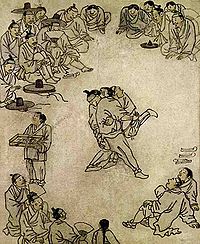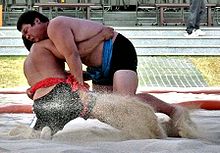- Ssireum
-
Ssireum 
The painting titled "Sangbak" (상박; 相撲) drawn by Kim Hong-do illustrates people gathering around to watch a ssireum competition in the late 18th century.Also known as gakjeo; gakhui; gakryeok; gakgii; chiuhui; sangbak; jaenggyo Focus Grappling Hardness Full-contact Country of origin  Korea
KoreaCreator Unknown Parenthood Historical Olympic sport No Ssireum (also spelled Sirum, Korean: 씨름) or Korean wrestling is a folk wrestling style and traditional national sport of Korea.
In the modern form each contestant wears a belt that wraps around the waist and the thigh. The competition employs a series of techniques, which inflict little harm or injury to the opponent: opponents lock on to each other's belt, and one achieves victory by bringing any part of the opponent's body above the knee to the ground.[1]
Contents
History
Gakjeochong (각저총:角抵塚) murals show that wrestling in Korea dates back as early as the pre-Three Kingdom era.[2] The Book of Later Han, a Chinese document that was written before the history of the Three Kingdoms also has records of Korean wrestling[citation needed].
Ssireum first gained widespread popularity during the Joseon Dynasty (1392-1910). Evidence of this is shown through the genre pictures of Kim Hongdo (see the above picture, Sangbak (상박:相撲)). In traditional life, Ssireum was a popular activity on the Korean holiday of Dano, the fifth day of the fifth lunar month, and tournaments are held in the summer and autumn. Ssireum competitions were also held on other days such as the Third Day of the Third Moon, the Eighth day of the Fourth Moon, Buddhist All Souls’ Day, etc[citation needed]. The traditional prize for winning a tournament was an ox, a valuable commodity in agriculturally-oriented society, which symbolized the strength of the contestant[citation needed].
The modern sport has developed in the 20th century. The first modern competition was held in 1912 at the Dansongsa theater in Seoul[citation needed]. Korean wrestling has been referred to as ssireum since the 1920s[citation needed]. The Pan Chosun Ssireum Federation was founded in 1927. Since 1947 the competition organised by the Ssireum Federation has been called the National Ssireum Championship Contest. Weight classes were introduced at the 12th National Ssireum Championship Contest, and revised in 1967[citation needed]. There are two traditional styles of Ssireum: a "right sided" style predominant in parts of the Gyunggi province, and Honam province of southern Korea, and a "left side" style favoured in Hamgyung province, Gyungsang provice and Choonchong province. The difference depended on the way the satba was fastened[citation needed]. In 1994, the Korean Ssireum federation, chaired by Hong sup Kim, proposed the unification of Ssireum in a single style and left sided Ssireum was adopted as the official style to be used by all competitors.
Etymology
Ssireum Hangul 씨름 Revised Romanization ssireum McCune–Reischauer ssirŭm Historically, there have been other terms for "wrestling" in Korean used alongside ssireum, such as gakjeo (각저:角抵), gakhui (각희:角戱), gakryeok (각력:角力), gakgii (각지:角支), chiuhui (치우희:蚩尤戱), sangbak (상박:相撲), jaenggyo (쟁교:爭交).[3] Gak (각:角), a commonly used prefix, seems to have originated from the combative act performed by horned animals such as oxen when competing against one another for the superiority of physical strength. Chinese people used to call Korean wrestling goguryogi (고구려기:高句麗技).
Method of competition
Ssireum is conducted within a circular ring, measuring approximately 7 meters in diameter, which is covered with mounded sand. The two contestants begin the match by kneeling on the sand in a grappling position (baro japki), each grabbing a belt (known as a satba), which is wrapped around his opponent's waist and thigh. The wrestlers then rise while retaining their hold on the other's 'satba.' The match is awarded to the wrestler who forces the other contestant to touch the ground with any part of his body at knee level or higher. Unlike sumo, pushing your opponent outside of the ring does not warrant a win, just a restart. Normally, professional ssireum is contested in a best-out-of-three style match.
There are 3 judges, a chief referee and three sub referees. The chief judge is positioned inside the ring, whereas the sub referees are located on the outside of the ring, one to the right and others to the left. If an unfair judgment is called or the chief referee is unable to render a decision, the sub referees can request a revocation of the decision or a rematch. In addition, they can recommend the cessation of the match when an injury occurs. The referees’ decisions throughout the competition are absolute and held in the highest regard, meaning that athletes cannot challenge any judgments declared during the match.
Today there are also women Ssireum wrestlers. Women wrestle only among themselves but follow the same rules (except that men are topless whereas women wear tops).
There are 4 weight classes in professional wrestling: flyweight (Taebaek), lightweight (Geumgang), middleweight (Halla), and heavyweight (Baekdu), named after the four famous peaks in Korea.
Traditionally Ssireum was contested with the top portion of the trousers rolled down to provide grip. The use of "satba" was invented with the birth of professional Ssireum in the mid-20th century. There is a movement to restore this traditional method of grip, in the spirit of maintaining its cultural and traditional roots, but it has met with some resistance as the use of "satba" has become entrenched in the modern form.
The professional league is dwindling in popularity and many wrestlers have turned their attention to mixed martial arts fighting, even though Ssireum involves no striking or submissions of any kind, as a means of making a living. Choi Hong-man, former champion of Ssireum, is enjoying notable success in the K-1 scene. Unfortunately, the future of professional Ssireum remains bleak, with only one team remaining. However, it can also be argued that Ssireum is beginning to undergo global expansion as a popular martial arts sport, alongside tae kwon do and hapkido.
It is important to note the differences between Ssireum and sumo. Ssireum has remained largely a national/traditional sport. Physical hits such as slaps and blows are not permitted in Ssireum, though they are in sumo. In both sports, the competitors are often quite large, though Korean wrestlers tend to be leaner. However, size does not guarantee success in either sport. Although both sports are quite similar, they differ in characteristics as well as values.
The national governing body of the sport in Korea, Korean Ssireum Organization, has made a claim that Ssireum is characterized as a "peaceful competition focusing on harmony and unison", reflecting the "philosophical outlook of the Korean Race".[4]
Cheonhajangsa Ssireum Championship
Past winners
# Year Winner # Year Winner # Year Winner # Year Winner # Year Winner 1 1983 Lee Man-Ki 2 1983 Lee Man-Ki 3 1984 Jang Ji-Young 4 1984 Lee Man-Ki 5 1984 Lee Jun-Hi 6 1985 Lee Man-Ki 7 1985 Lee Man-Ki 8 1985 Lee Jun-Hi 9 1986 Lee Man-Ki 10 1986 Lee Bong-Geol 11 1986 Lee Man-Ki 12 1987 Lee Bong-Geol 13 1987 Lee Jun-Hi 14 1988 Lee Man-Ki 15 1988 Lee Man-Ki 16 1989 Lee Man-Ki 17 1989 Kim Chil-Kyu 18 1990 Kang Ho-Dong 19 1990 Kang Ho-Dong 20 1990 Kang Ho-Dong 21 1991 Hwang Dae-Woong 22 1991 Hwang Dae-Woong 23 1991 Kang Ho-Dong 24 1992 Kang Ho-Dong 25 1992 Im Yong-Je 26 1992 Kim Jung-Pil 27 1993 Kim Jung-Pil 28 1993 Baek Seung-Il 29 1993 Baek Seung-Il 30 1994 Shin Bong-Min 31 1994 Baek Seung-Il 32 1994 Lee Tae-Hyun 33 1995 Kim Kyung-Soo 34 1996 Kim Kyung-Soo 35 1997 Shin Bong-Min 36 1998 Kim Young-Hyun 37 1999 Kim Young-Hyun 38 2000 Lee Tae-Hyun 39 2001 Hwang Kyu-Hyun 40 2002 Lee Tae-Hyun 41 2003 Choi Hong-Man 42 2004 Kim Young-Hyun 43 2008 Yoon Jung-Su 44 2009 Hwang Kyu-Yeon See also
References
- ^ What is Ssireum? Korean Ssireum Research Institute.
- ^ (Korean) General information about Ssireum at Yahoo Korea Encyclopedia
- ^ (Korean) Origin and definition of ssireum 씨름의 정의 Yongin University Ssireum Research Center
- ^ http://www.ssirum.or.kr/korea/kor_ssireum01_eng.php
External links
- (Korean) Korean Ssireum Organization: 한국씨름연맹 - Official Website
- Korea Ssireum Research Institute
- Swiss Ssireum Association
- Korean Festival
- Antonio Graceffo writes about his experience of practising Ssireum wrestling in Korea
- History of Ssireum in Korea
Korean martial arts Striking Grappling Weaponry Hybrid GongKwon Yusul · Hankido · Han Mu Do · Hapkido · Hwa Rang Do · Kichun · Kouk Sun Do · Kuk Sool Won · Kuk Sul Do · Kung-fu · Kung Jung Mu Sul · Kunmudo · Seon-Kwan-Moo · Shippalgi · TaekkyeonRelated Hyeong · Dobok · Dojang · Kwans · Sae Sok O-Gye · Muyejebo · Muyesinbo · Muyedobotongji · Hwarang · SsaurabiModern Choi Kwang-Do · GongKwon Yusul · Han Mu Do · Hankido · Hankumdo · Hapkido · Kichun · Kong Soo Do · Kouk Sun Do · Kuk Sul Do · Kuk Sool Won · Kumdo · Kung-fu · Kung Jung Mu Sul · Kunmudo · Moo Duk Kwan Taekwondo · Shim Gum Do · Soo Bahk Do · Sunmudo · Taekwondo · Tae Soo Do · Tang Soo DoJoseon Ancient Traditional weapons · SwordsMartial arts Regional origin Unarmed Weapons Training Grappling Folk wrestling · Brazilian Jiu-Jitsu · Catch Wrestling · Judo · Lucha Libre · Shoot wrestling · Greco-Roman wrestling · Freestyle wrestling · JujutsuFull contact sports Bare-knuckle boxing · Boxing · Full contact karate · Kickboxing · Mixed martial arts · Muay Thai · Sanshou · Shooto · Sambo · TaekwondoSelf-defense/Combatives Entertainment Categories:- Folk wrestling styles
- Korean martial arts
- Ssireum
Wikimedia Foundation. 2010.



